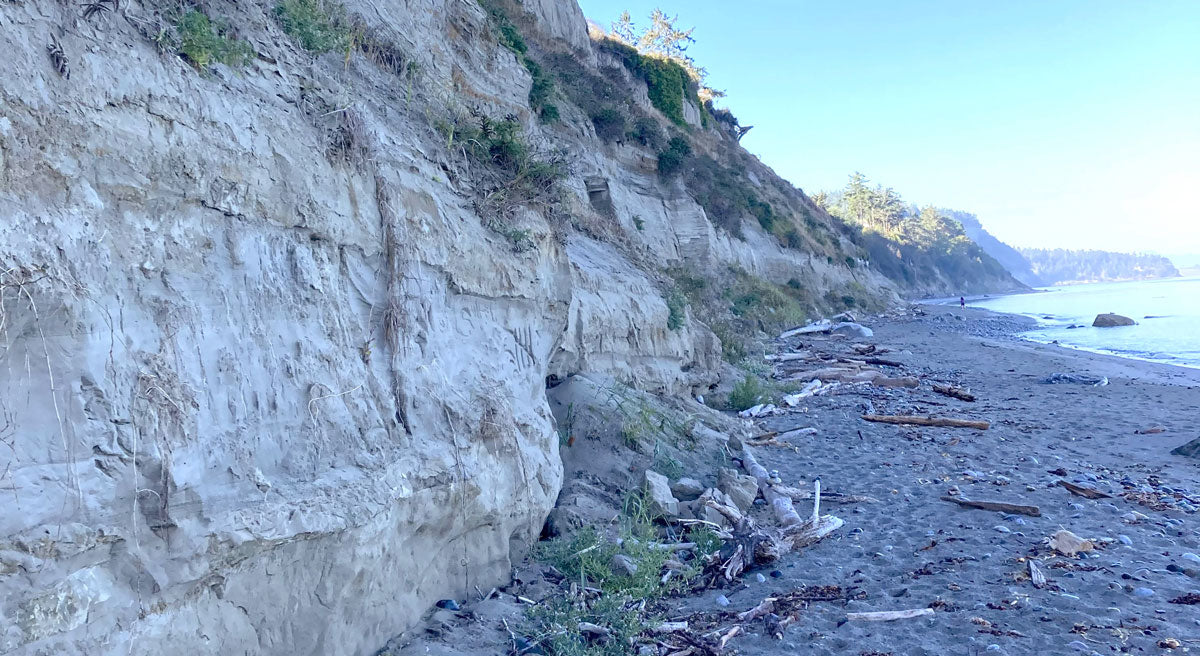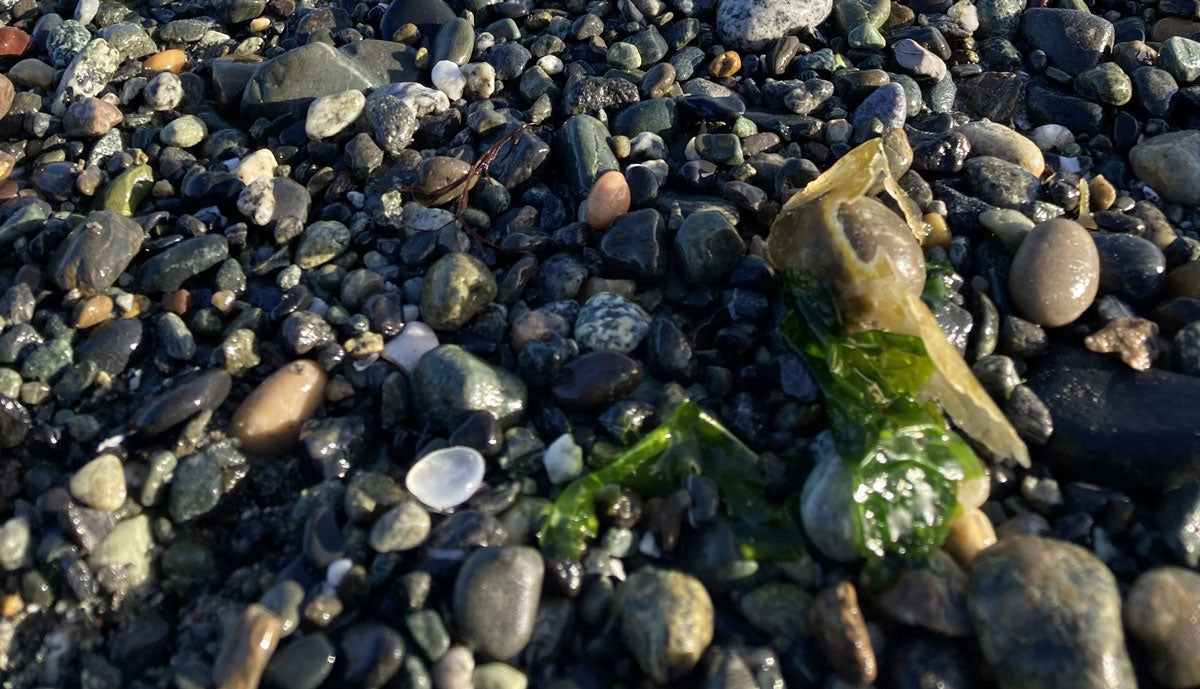Sea Glass Hunting Tips from a Seasoned Sea Glass Hunter
By Andi Clarke

As a long time sea glass lover and hunter, I’d love to share some of my sea glass hunting tips with you. I hunt for jewelry-quality pieces of sea glass to use in my sea glass jewelry and I also collect larger pieces for craft projects. I’m a sea glass addict, though I’ve told my husband that there are worse addictions. So, here are my best tips based on nearly 20 years of sea glass hunting.
- Research the tides for the beach you are going to and try to go a bit after high tide so that you can walk the beach as the tide recedes. There are also usually more forceful waves at high tide which have the potential to bring in bigger pieces of sea glass—and going after spring high tides or storms is the best. Learn more about tides ›

- If your beach has pebbles, shells, or debris to dig through, bring some type of tool like this gardening one to help you rake through the pebbles or shells and find the hidden sea glass. I’ve even used a mini mesh office garbage container and I have run into waves, scooped out stuff, and then sorted it on the beach. Beachcombing gear ideas ›

- Wear appropriate shoes for your beach. I’ve been very happy to have flip flops on a beach in Barcelona with incredibly rough sand, and I was extremely happy to have worn my hiking boots on this rough and pebbly beach in Washington state where we live. I’ve also been happy to have rubber Wellington boots so that I could wade in colder water and see the sea glass that the waves weren’t bringing up.

- Remember the tides suggestion from tip number 1, this one is about knowing your beach well or researching it before you go. The beach I go to is well known for its steep bluffs. You always go this beach as the tide is heading out and come back before the tide is in. These sandy bluffs are quite steep and would be impossible to climb during a spring high tide. I’ve even met someone who had to call the U.S. Coast Guard, because they got stranded here and were at the risk of drowning.

- Walk the tide line as you head out and if it’s a bit after high tide, head in a zigzag pattern covering where the high tide mark is and where the waves are breaking. On your return, you can do the gap where you walked previously and where the waves currently are.

- Watch out for rare purples, browns, or olive green pieces of sea glass masquerading as pebbles. Sea glass has a bit of a glow, so look for that and hold the pieces to the light.

- If a sea glass piece is not quite ready yet, toss it back for another 10–20 years of weathering and perfecting. The next generation of sea glassers will enjoy finding it in the future.

- If the sea glass hunting isn’t super plentiful, just enjoy being in nature with the people you are with or enjoy other marine life, like an incredibly huge mussel shell or an artfully balanced stack of pebbles.

- The best beaches for sea glass hunting are urban beaches where bottles may have been broken like the one in Cape Town (in South Africa) pictured above, or beaches which may have been old garbage dumps like Port Townsend (in Washington), Dead Horse Bay (in Brooklyn), Hanapepe (in Hawaii), or Fort Bragg (in California). Beaches that have well-rounded and jewelry-grade-quality sea glass are ones that have large waves, big storms, and sand and rocks to weather and perfect the pieces of sea glass. I’ve also heard that the old shipping routes (and shipwrecks) along the Great Lakes in the U.S. are excellent for finding beach glass, which incidentally is the term for weathered glass found in fresh water. They also have significant waves on those lakes to help weather glass really nicely.

- If you want to find sea glass marbles, look at beaches where kids may have played or beaches which may have been local garbage dumps. Marbles were used in spray paint cans, and in older communities, you may find Codd marbles, which were used as stoppers in old soda bottles. Marbles are also from Ramune bottles from Japan. I found the marble pictured above near Cape Town, South Africa, which has been a busy port for a few centuries. I think I also got lucky with a spring low tide and I looked in the tide pools where the marble had lodged as it was too heavy to be carried by the gentle summer waves. Learn about industrial or railroad marbles from the Great Lakes.

- Bring a friend or family member who isn’t addicted to sea glass like you. The sea glass in the photo above was all found by me, one of our daughters, and my husband on one beach trip. All of these pieces will be used to make my sea glass jewelry designs.

Of course, like most sea glassers, I cannot resist picking up big pieces of sea glass—especially if they’re gorgeous pieces—which I often use sea glass in crafts. I used the pieces above that I found in Barcelona, Spain, to make a sea glass mobile that catches the light.
I hope you’ve enjoyed this article and hope that it will help you find sea glass in the future.
Check out what to pack and bring on a beachcombing vacation.
Learn more about Andi, check out her distinctive sea glass jewelry and collages, and learn how to make your own sea glass mobile on Andi’s website at www.andiclarkejewelry.com.
This article appeared in the Beachcombing Magazine January/February 2022 issue.
Oceancombing for treasure ~ Ocean Safety Tips
Underneath the water is a whole new world of hunting for sea glass and empty shells. It’s not without its dangers though when you combined currents, waves, changing tides and rising swells. It can be done safety by knowing your limits. JJ and Pat Caldwell explore some lifesaving techniques and tips to make this underwater search more enjoyable.
Learn more about beachcombing gear
Recommendations for selecting the best beachcombing gear for your next trip to the beach. Articles ›







